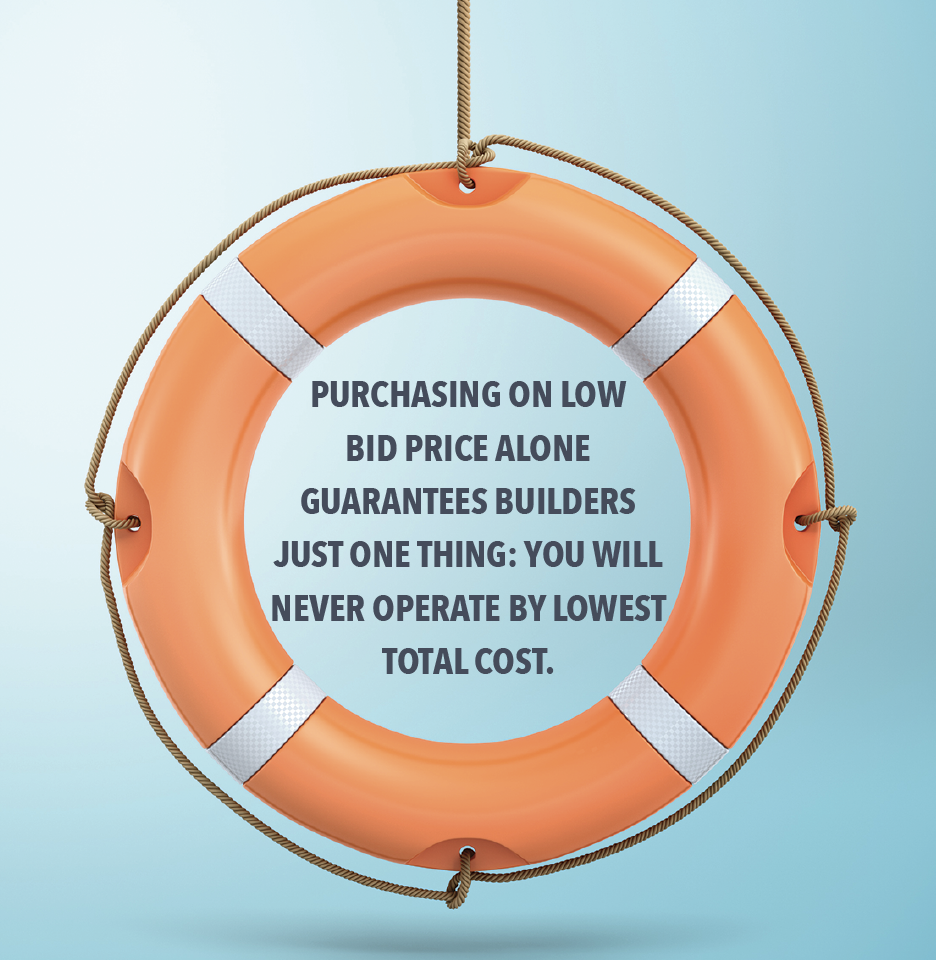I’ve written three columns this year on how builders can prepare for a housing slowdown that some industry experts predict will intensify during 2020. Indeed, in many markets today, permits have fallen from a year ago. The downturn may be mild or something more serious, but either way, most home builders will confront some hard choices.
But what about building products suppliers? The industry is just getting back to a supply chain that flows reasonably well after a wave of manufacturing plant closures during the big crash, and now suppliers are again facing tough decisions. In many ways, it’s harder for them because, unlike home builders, their labor consists of mostly payroll employees that can’t be scaled up or down with the flip of a switch—or a phone call.
RELATED
- Part 2 in this series: Supplier Survival: Adopt a Highly Differentiating Approach
With builders telegraphing significant concern today, suppliers report price competition is getting more intense. Ask anyone who has ever sold anything for a living; there’s nothing more demoralizing than getting up each day and feeling like your only option is to cut price to get the sale and maintain cash flow. That’s just the way it is, right?
My Life as a Yard Dog for a Large Commercial Lumberyard
While pondering these questions and considering the very best suppliers our TrueNorth team has worked with during more than 200 home building Lean process implementations, a memory surfaced from literally decades ago that suggests a solution for suppliers with the brains and guts to adopt it.
My first brush with the idea of a truly different supplier strategy, strangely enough, came on a hot August morning near the end of my third summer working as a “loader helper” for a large commercial lumberyard during college. Mostly I worked with “Doc,” a grizzled old guy who literally knew everything there was to know about lumber, millwork, sheathing, siding … you name it. He was a stickler for getting it right the first time. In those three summers, Doc had never called in sick, until that day. Mel, the no-nonsense yard manager walked up to me with a ticket and said, “Well kid, today you’re on your own. Make Doc proud.” Then, out of all the customers we serviced, Mel handed over the order sheet for Green Brothers.
Green Brothers! With only the slightest of smiles, Mel said, “You know Doc is the only loader I let do Green Brothers. All these other yahoos around here will screw it up. Since you’re Doc’s guy, I’ve got to trust you with it. I don’t care if it takes you all day, get it done, and get it right.”
A Home Builder That Has High Standards and Supplier Expectations
Part of me took this as a big compliment, while another part was scared to death. So, what was different about Green Brothers? Compared with more than 100 other home builder customers we served, just about everything. Green Brothers was one of the largest builders in town, and we got all of their business—on the condition we met all of their demands. Those demands were:
1. Specifications precisely detailed and always met
Green Brothers always specified the type and species of lumber required, and under no circumstances could we vary from what was ordered. If they spec’d 4x8 CD plywood, it damn well better be CD, not CDX. If they said southern yellow pine and you gave them hem fir, you’d be picking it up the next day. If your load sheet said 20 pounds of 16d CC nails, they’d better not be 16d commons, or a hot-shot order was a given. With other builders, we did what was easiest for us. For Green Brothers, we did what they wanted—to a T ... or else!
2. The highest material quality
The material had better be the right grade, straight, and dry … period. No substitutions. No exceptions. And none of the #2 studs that looked more like utility grade.
3. Correct sizes
Of course, if a builder orders 88 2x6 10s, you’d never give them 8 footers. But when the 10s are buried four stacks deep and Ernie the fork driver is hung over (again), you just give them 12s from the pile in front, right? Not for Green Brothers. They didn’t want to pay their framers for making 88 2-foot cuts, and they sure didn’t want to pay to haul away the cuts-offs in a dumpster and bury them.
4. Loading in the correct order
The load was stacked so it came off in the order the framers would need each component. Easy to say, harder to do, and it takes some thought, but Green Brothers insisted on it. They had started as framers and knew what a difference it makes. And the little corners that protect the materials as you cinch them up tight with your bander? You’d better not drop one and cut into the load, damaging material, or there would be yet another return trip to the Green Brothers’ site.
5. Scheduled delivery on time—every time
There was no “drop it early” with Green Brothers, and there certainly was never ever a “drop it late.” If they weren’t ready for it, they didn’t want it sitting out getting damaged, wet, or stolen. And when it was dropped, you could be sure the framers were on it before the truck got back to the yard. Lord help you if you got a call from them saying their framing crew was waiting on a load.
6. Drop location specified and adhered to
Every Green Brothers site had a map showing exactly where they wanted each load dropped and by God that’s where the driver better put it. I’m not saying some of our less-thoughtful drivers had never dropped a load in a mud hole, on top of debris, or in the way of another supplier or trade, but I can assure you they never once did that for Green Brothers.
7. Load confirmed and inspected every time
Not one time did I go to a Green Brothers’ site and there wasn’t someone there to inspect the load, count it, and check the load sheet. Both the site superintendent and the driver signed it, and if there was any discrepancy, it was corrected that same day. But since Doc took over assembling all of their loads, discrepancies were virtually unheard of.
I loaded up Green Brothers perfectly that day, although it took most of my eight hours. Doc and I together could have done it in three. Anytime I was unsure, I’d just stop and think, “What would Doc do?” and the answer came quickly.
It was a funny thing about Green Brothers’ orders; they required extra planning, thinking, and sometimes more work, although with enough thinking, most of the extra work was avoided. There was a certain pride in putting those loads together perfectly. Doc clearly felt that, as did I. He’d moan and groan about them, but just let Mel hint at giving a Green Brothers order to another loader on a busy day and Doc would jump up and growl, “That’s mine!” He’d grab the ticket, fire up the Farmall tractor, and head out with me running to catch up.

A Supply-Side Revelation for Home Builders
The next day at lunch I sat at one end of a long lunch table with the “yard dogs” as Mel somewhat affectionately called everyone in the place who was not him. I was happy to see Terry, our high-energy, super-friendly, 30-ish salesman walking through the door. Terry had also paid his dues working the yard throughout college. He was fun and always had a ready joke to lighten the mood. Terry wasn’t so happy that day, though. The economy had slowed, housing starts were down and thus so were orders for the yard, affecting Terry’s paycheck.
While everyone joined in the “ain’t it awful” chorus, this bright, young college kid had an idea. “I know how to increase sales,” I declared for all to hear. Mel and Terry stopped mid-sentence, not expecting this from a 20-year-old yard dog. Terry gave me a quizzical look. He was either curious or looking for more fodder for one of his jokes though, so he turned to me and said, “OK, let’s hear it, kid. No one else around here seems to have any ideas.”
“It’s simple,” I said. “Let’s treat every builder like we do Green Brothers.” I began to explain, but my idea went over poorly; everyone waved me off, grabbed their hard hats, packed up their garbage—along with my idea—and dumped it in the trash on their way out.
Their comments were dismissive, to put it mildly. Didn’t I realize that would take extra work? Didn’t I know other builders wouldn’t appreciate the extra effort? Couldn’t I see we didn’t have the manpower (or, as Terry later told me, the “brainpower”) needed to get all of those details and specifications from the builders, load them right, drop them properly, and get confirmation? The coup de gras came from Mel himself, “Jeez kid, get in the real world, would ya? I guess they don’t teach that in your high-class college.” As we walked out, Doc just looked at me wearily and asked, “What are you doing, kid, trying to kill me?”
Now and then I think back on the characters in that yard. I never expected the knowledge I gained there to come in so handy later in my career. I can still tell just about every size and type of lumber at 30 feet and have a nearly encyclopedic knowledge of nail sizes and types—something good to fall back on! But I confess, I didn’t think much about Green Brothers until 30 years later, while working with a similar builder with like expectations.
This builder was having trouble not just getting a lumber dealer to meet its needs, but was similarly frustrated with suppliers of shingles, doors and windows, paint, drywall, fixtures, cabinets, and counters—virtually every component of the house. The suppliers in the area were consumed by down-and-dirty price competition because, in truth, low bid price was the builders’ sole focus. This home builder, however, was asking for something quite different, the same things I saw from Green Brothers so many years ago. Yet, just like my pals back in the lumberyard, his suppliers didn’t have the ears to listen nor the eyes to see.

Do Home Builders Really Only Care About Bid Price?
I know what most suppliers are thinking right now; the question at the heart of it boils down to this: Do builders really care about anything besides bid price?
I often make a statement in my presentations to home builders that some consider radical: “The only thing that purchasing on low bid price alone guarantees is you will never operate by lowest total cost, and total cost is the only thing that matters.” Yet, how can this be radical, when it’s the simple truth?
Well, it is if you know how to measure total cost. The reality is, industry suppliers are continually confronted by myopic, low-bid builder tactics that result in greater total cost. This makes it difficult for suppliers to believe there’s a better, more effective way to sell.
For example, one national builder wrote a low-bid contract with a supplier to direct-ship plumbing fixtures to jobsites. The price was so low the supplier stated, “We don’t make any profit on that deal, but we do it for the volume to keep the factory going.” The VP of purchasing got a big bonus that year based on the money saved through this contract—on paper. Of course it was the field that was left to cope with the persistent delivery problems, theft of material, wasted trips by plumbers, VPOs for rush orders, and compounding schedule delays. A net loss, but no one measured all of the factors. Here are a few more examples.
- A nationwide drywall contract was secured with a very low price per square foot for material, but the labor for stocking the drywall into the houses had to be purchased locally. The outcome: damage and delays that exceeded the savings on board.
- A large insulation contract came with the lowest price, but material shortages forced local superintendents to rent panel trucks and drive long distances to Lowe’s or The Home Depot in other cities, paying retail price for the material needed to stay on schedule. A net loss.
- To save money, a builder gave responsibility for window installations to the framer, not the window supplier. Within months it was clear that the framer’s quality and attention to flashing details didn’t compare to the work done by the supplier’s trained crews. Service and warranty calls soared, resulting in unhappy customers. Yet another loss.
Despite these and countless other examples, there are home builders that are comparatively enlightened, seeing beyond bid price to total cost and highest value. Many more are open to learning, but only if the supplier does the legwork and brainwork to enlighten them. We have seen this time and time again among the more than 5,000 supplier and trade firms we have met through Lean implementations.
No, such proposals and ideas from suppliers aren’t always accepted by home builders, but those that are literally change the game. On the surface, the approach looks like a simple “value-added” strategy—provide a package of products, services, and support that helps insulate a supplier from builders purchasing on bid price alone. That’s a start. But for the very best suppliers, it goes much deeper than that, all the way to an approach that truly is radical. I call this approach “Strategy Z” and it can help a supplier not just overcome price competition today and survive a slowdown but thrive in any market. We’ll tackle that in detail next month.
For a free PDF of Scott’s “Preparing for the Downturn” and “Bridging the Margin Gap” column series, email your request with contact information to info@truen.com. You may reach Scott at scott@truen.com or 248.446.1275
Access a PDF of this article in Professional Builder's November 2019 digital edition













